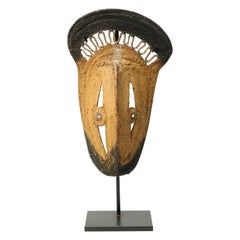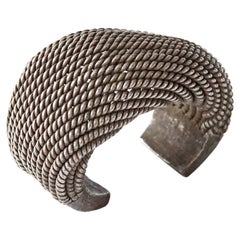Tribal Art
Tribal Art For Sale
Color: Yellow
19th Century Brass Pendant on Yellow Multi-Strand Beaded Necklace, Naga, India
Located in Point Richmond, CA
19th century brass pendant on yellow multi-strand beaded necklace, Naga, India
A graceful necklace of small yellow glass trade beads bead...
Category
Early 20th Century Indian Tribal Tribal Art
Materials
Brass
Early Papua New Guinea Sepik Woven Yam Mask Yellow Pigments on Custom Base
Located in Point Richmond, CA
Early Papua New Guinea Sepik River area tightly woven raffia yam mask with areas of heavy yellow and black pigments. In profile small bird beak form at bottom...
Category
Mid-20th Century Papua New Guinean Tribal Tribal Art
Materials
Organic Material
Related Items
Antique Akha Hill Tribe Silver Cuff Bracelet, 517grams
Located in Jimbaran, Bali
An exceptionally large Akha Tribe woven silver bracelet with spiral design. This Tribal bracelet encompasses tradition Hill tribe silversmithing techniques ...
Category
Early 20th Century Thai Tribal Tribal Art
Materials
Silver
Naga Ceremonial Shields from the Naga Tribe in Burma 18th-19th Century
Located in New York, NY
Behold the captivating beauty and profound cultural significance of the Naga Ceremonial Shield, a remarkable piece of artistry and heritage. This exceptional shield, exquisitely craf...
Category
Late 18th Century Burmese Tribal Antique Tribal Art
Materials
Hide, Paint
Papua new Guinea Sepik Turtle stool Head Rest Oceanic Asian Tribal Art
Located in London, GB
Sepik Turtle stool Head Rest Oceanic Polynesian Australian
A cute small stool or Headrest carved in the form of a turtle from the Sepik region of Papua new Guinea
A beautiful objec...
Category
Mid-20th Century Papua New Guinean Tribal Art
Materials
Slate
H 5.91 in W 11.82 in D 5.91 in
Traditional Silver Torque Necklace Chocker from Rajasthan India
Located in North Hollywood, CA
Traditional torque or Hansuli silvered necklace choker from Lambadi or Banjara and Sugali People, Andhra Pradesh, India.t India, circa 1940.
Fabulous vi...
Category
Early 20th Century Indian Folk Art Tribal Art
Materials
Metal, Silver Plate
Antique Hill Tribe Silver Spiral Cuff Bracelet, Hand-Engraved, Thailand, c. 1900
Located in Jimbaran, Bali
This unique tribal cuff bracelet originates from the Karen Hill Tribe of Northern Thailand via tribal silversmith techniques that have been handed...
Category
Early 20th Century Thai Tribal Tribal Art
Materials
Silver
Free Shipping
H 3.55 in W 4.34 in D 1.19 in
19th Century Hindu Temple Fragments from India Mounted on Bases
Located in Atlanta, GA
Four 19th century Hindu temple fragments from India. These temple fragments were elements of a frieze and have been mounted on a custom-made, black painte...
Category
19th Century Indian Antique Tribal Art
Materials
Metal
Ngbaka Congolese Tribal Mask for Initiation Rituals, Early 20th Century
Located in London, GB
With a beautiful dark patina, this early 20th century wooden mask shows a naturalistic human face, flattened, with the forehead, open mouth and stylised teeth in light relief; the ri...
Category
Early 20th Century Congolese Tribal Tribal Art
Materials
Wood
H 12.6 in W 8.67 in D 3.94 in
Antique Ethnic Brass Traditional Anklet Bracelet from India Vide Poche
Located in North Hollywood, CA
Dhokra art old ethnic tribal brass traditional ankle bracelet from India, repurposed as ashtrays ,catchall, or vide poche.
Handcrafted of a hollow band of heavy brass decorated with chevron repoussé banding and lost wax granulation.
The brass inner plate was later added to use the bracelet as a small ashtray.
The closure was a push pin mechanism that was closed.
India, circa 1920s.
Measure: 7"5 D x 2" H.
"Dhokra is an ancient folk art tradition prevalent in India in the eastern states of West Bengal, Odisha, Jharkhand and Chhattisgarh. Dhokra craft objects are made through the process of non-ferrous metal casting using the lost-wax casting technique, which is one of the earliest and most advanced methods of metal casting known to human civilization. Its roots can be traced back 4500 years to the ancient city of Mohenjodaro in the Indus Valley Civilization.
The name Dokra or Dhokra was used to indicate a group of craftsmen of nomadic type from the Dhokra Damar tribe, scattered over the regions of Bengal, Orisa and Madhya Pradash, whose wares were identified by their beautifully shaped and decorated metal products. The enchanting Dhokra art objects have motifs inspired by indigenous folk...
Category
Early 20th Century Indian Anglo Raj Tribal Art
Materials
Metal
Fiber Polychrome Mask Yam Ancestor Papua New Guinea
Located in Atlanta, GA
A well preserved Yam Ancestor mask professionally presented on a museum quality acrylic display stand. The mask was a classic tribal art piece from Abela...
Category
Mid-20th Century Papua New Guinean Tribal Tribal Art
Materials
Natural Fiber, Acrylic
Naga Ceremonial Shields from the Naga Tribe in Burma 18th-19th Century
Located in New York, NY
Behold the captivating beauty and profound cultural significance of the Naga Ceremonial Shield, a remarkable piece of artistry and heritage. This exceptional shield, exquisitely craf...
Category
Late 18th Century Burmese Tribal Antique Tribal Art
Materials
Hide, Paint
Antique Akha Hill Tribe Silver Cuff Bracelet, Golden Triangle
Located in Jimbaran, Bali
An Akha Tribe Woven Silver Bracelet with spiral design. This Tribal bracelet encompasses tradition Hill tribe silversmithing techniques with each silver str...
Category
Early 20th Century Thai Tribal Tribal Art
Materials
Silver
Free Shipping
H 2.37 in W 3.15 in D 1.11 in
Antique Ethnic Artifact Sepik River Cassowary Bone from Papua New Guinea
Located in North Hollywood, CA
Antique Ethnic Artifact Sepik River Cassowary Bone from Papua New Guinea
For many groups in Papua New Guinea, bone was an important medium for making tools of all types. This artifact is made from leg bone of a cassowary, a large, flightless, and extremely dangerous, bird.
Cassowaries also play an important role in the mythology of groups in the Sepik River area.
Though no longer used these bone artifacts are still used ceremonially. They often play important roles in male initiation and other rituals. They are also worn as personal adornment by tucking them into a band of braided fibers worn around the upper arm.
Antique Ethnic Bone Cassowary Artifact with minimal carving and incised design confined to the joint end.
A small hole has been drilled through from both sides of the top and presumably for the threading of a cord.
The bone has been partially divided near the top and to form two prongs that project down the back of the dagger possibly allowing the user to wear is tuck into a waist band or belt.
Origin Papua New Guinea Maprik Dist Area
From the Art Collection of Marian and John Scott, acquired in 1962.
Similar items are in display in the Timothy S. Y. Lam Museum of Anthropology.
Purchased from the amazing private collection of Mark Lissauer who spent his life collecting niche ethnographic pieces.
About Mark Lissauer:
Mark Lissauer spent forty years travelling abroad for months at a time collecting ethnographic artefacts primarily from New Guinea and the islands of the West Pacific, and from Asia and Himalayan countries. Fluent in five languages and having in the course of business travelled to more than forty countries, Mark is well-known to museums and art-collectors around the world for his long career and his interesting and diverse collection of rare ethnographic material.
Mark knows the origin and symbolism of each piece. Through extensive research and more than ninety trips around the globe, Mark familiarised himself with the traditions of the various cultures he visited in order to understand the meaning of each object to its region and tribe. His home has a specialist library and several rooms are filled with tribal carvings, textiles and ethnographica.
He acquired his first tribal piece in 1948 during a business trip to Milne Bay, New Guinea, and has since documented the acquisition of some 35,000 items. Several thousands of these have been sold to important private collections and museums worldwide, including the Rockefeller Museum, the British Museum and the Musée National des Arts d’Afrique et d’Océanie, now incorporated into the Louvre Museum.
Estimator certificate of authenticity by Wayne Heathcote Tribal Art Dealer and Expert.
Heathcote has a flash gallery in Brussels, where much of the tribal art business is centred, and is an expert at Sotheby's tribal art sale...
Category
Early 20th Century Folk Art Tribal Art
Materials
Bone



